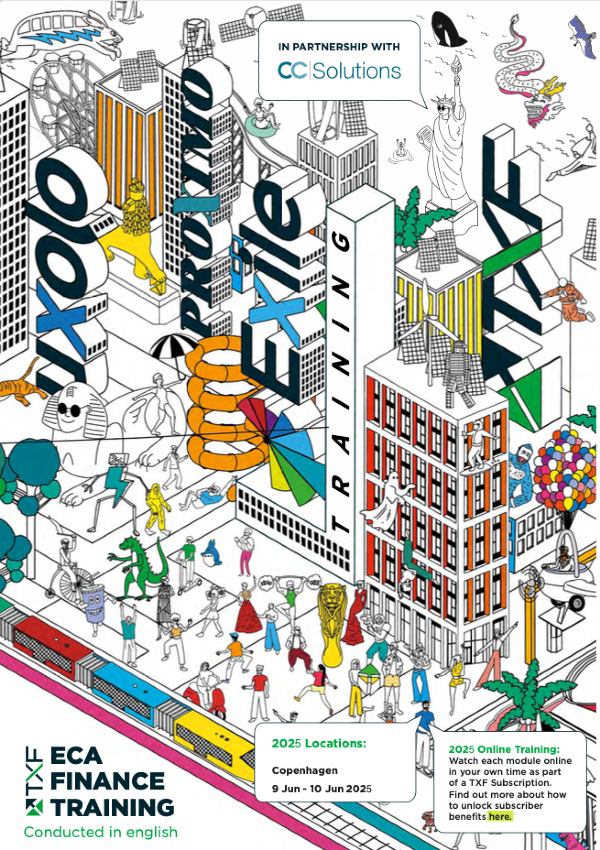How much of the $1.5trn trade finance gap can tech bridge?
The $1.5 trillion trade finance gap is a heavy burden for SMEs in emerging markets, one which financial institutions have long sought to ease. In partnership with Comarch, TXF hosted a webinar to consider the extent to which technology can bridge this gap.

The $1.5 trillion trade finance gap has long cast a shadow over the market. This shadow looms not least because of its vast scale, but because of its disproportionate impact on emerging markets, SMEs, and women and minority-owned businesses.
Over the years, banks have developed a toolkit of solutions to help plug this gap, including a growing range of tech-based tools. However, while the industry has dipped its toe into digitisation, we are yet to see a full tech transformation.
The $1.5 trillion trade finance gap has been consistent over the past years, however there is some talk of this gap widening up to as much as $2.25 trillion. This represents not just a threat to SME clients, but a huge missed opportunity that banks often overlook. But where does this gap come from, and how can banks support clients hit the hardest by this funding shortfall?
Joined by an audience of market professionals, TXF hosted a webinar in partnership with Comarch to consider the extent to which technology can bridge the trade finance gap and, crucially, the steps needed to take this further.
Hesham Zakai, managing director at TXF, moderated a discussion between Alex Fadani, business development manager for financial services at Comarch alongside Johanna Wissing, director of global transaction banking at Lloyds Bank. They took on the barriers and hesitations around a tech transformation and much more importantly, the opportunities.
A burden for emerging market SMEs
Surveys conducted around the time of the global financial crisis (GFC) suggest that the trade finance gap existed, at that time, due to a lack of credit. However, as we emerged from the crisis and liquidity was more readily available, the gap remained: a lack of liquidity could not be the only cause.
When the same surveys are taken today, market sentiment is clear: stringent regulation, compliance, AML and KYC play a pivotal role in preventing access to finance. In today’s market, Wissing says, ‘the dominant factor seems to be the regulatory frameworks and requirements and the cost of compliance rather than the cost and availability of credit.’
Of course, as the GFC taught us, regulation is necessary. The prevention of illegal financing of terrorism, human trafficking, and the like, should be in everyone’s interest. However, this means that banks must widen their toolbox to help make finance accessible to SMEs, those who are most heavily penalised.
If being an SME is a barrier to finance, then operating in emerging markets makes it even harder. This is due in part to the fact that local banking markets in smaller countries don’t have access to the same global networks as developed market counterparts.
Lloyds Bank, a UK institution, relies on its correspondent banking relations to promote UK business and ensure that credit lines are made available as much as possible. Although these relationships are the result of diligent work, they are very much within the realms of possibility for a market like the UK.
These global relationships are not as easily built in smaller markets like the Caribbean and some small countries in Asia Pacific. It is therefore not just the bank’s own internal regulatory procedures that inhibit SME access to trade finance, but the footprint of local banks and their global networks.
Further, local bank markets may not have access to reliable, resilient systems which are necessary to facilitate SME trade.
We can’t know precisely how many credit applications from SMEs are rejected, but we can be sure that the figure is high. Banks have a growing toolbox of solutions for SME customers, including support from government agencies, supra-national bodies like the ICC, and technology should be used to add more tools to the box. Since the GFC we have seen a much larger array of banks using these types of tool to mitigate credit risk – but what, we asked, makes for a viable tech-based trade finance solution?
The perfect balance for trade tech
There are many ways that technology can be embedded into banks’ existing architecture to improve access for SME and EM clients. The website interface that they use to interact with clients is the first port of call for many, and it therefore represents an excellent opportunity to engage with clients’ needs.
According to Comarch, banking websites should make communication as streamlined as possible. They should be enabled with instant messaging, video chats, and 24-hour access. These measures reduce the number of meetings and phone calls, which optimises costs for banks as well as eases access for customers. Further, a fully supportive website can encourage clients to seek out banks in the first instance, rather than business origination having to rely on banking outreach.
It may seem surprising, but a shocking number of institutions still rely on paper-based applications at some point during the onboarding process. This, says Fadani, is just not efficient enough. ‘Even the most digitally enabled banks still use paper-based system at some point. You can end up with a double or even triple entry from different people – we just can’t continue like this.’ We must transition, Fadani says, to a one-stop-shop marketplace model that is fully digitised from end-to-end – with no room for paper.
New technology will create growth. Big Data could help us to analyse trade patterns on a broader scale, allowing us to see risks much earlier on. Artificial intelligence can also be used to create more efficient and sustainable trade finance channels. The question now, Fadani says, should be ‘following a year of trade wars, barriers, and the great lockdown – can banks really avoid tech any longer?’
Assessing the reluctance
There remains a lingering reluctance to make the tech transition amongst some market practitioners. We polled our audience to find out the main obstacles for IT change in their business. The overwhelming consensus, at 43% of voters, was that the high cost of technology implementation is their biggest barrier. 32% cited the length of implementation, 21% were concerned by the lack of international standards, and only 4% cited low digital responsiveness from customers.
It’s clear, then, that tech transition is in clients’ interests – it’s the timely and costly implementation that causes the problem. ‘Many institutions see the implementation of technology as an obstacle rather than a tool to ignite growth,’ says Fadani. Indeed, a lot of institutions still use legacy technology that can be difficult when it comes to integrating new solutions. ‘Implementation requires an initial investment of time, people, money, resources – but new technology must be seen as a solution’, Fadani continues.
The long-term benefits, he says, far outweigh the initial cost. It is hard to embrace change from the outset, but more effective solutions will come to save time, money, and resources.
Trade, as we know, can be subject to fraud – this is another factor that elicits some hesitation when it comes to relying on tech. In fact, if done the right way, tech can help prevent money laundering and speed up the process in the meantime.
For example, some AI based tools can optimise online onboarding as they are linked to the global identification database and can verify clients’ identities in a streamlined, efficient manner. AI can provide deeper analyses of existing cases of fraud and reduce the number of false positives we can come across in manual AML processes. Overall, by streamlining AML and KYC procedures, tech- based solutions can mitigate the very barriers that make access to finance so difficult for SMEs.
A case of competition?
For the past few years, some institutions have expressed concern that emerging FinTech space will overcrowd the banking market. However, as Wissing says, ‘today the potential for collaboration outweighs the threat of competition.’
Despite some reluctance caused by initial investment, the majority of banks understand the benefits of new technology. However, their priority is and should remain providing the best service to customers, rather than delving into the technicalities of digital solutions. This, our panellists agree, is where partnership is key.
In the initial stages, banks should be clear with tech partners as to their aims. Are they investing in tech to reduce manual work? To streamline processes? To implement new procedures? To reduce operational costs? To access new clients? Once these goals are established, technology partners can help to develop the optimal solutions. Even Lloyds, whose recently upgraded digital platform is state of the art, is keen to collaborate with external providers.
Promissory notes and Letters of Credit (LCs), says Wissing, are fantastic candidates for digitisation via collaborative effort. They are some of the oldest and most trusted tools in the trade finance kit, and for good reason. Collaboration between bank and tech providers would work incredibly well to ‘supercharge’ these already robust trade finance tools, making them more streamlined.
The difference lies not with the tech capacity, but with industry standards. Traditional trade finance instruments like the LC have very clear rules, such as the uniform customs code, which make it easy to process LCs in most countries. The lack of standardisation in other instruments is the reason that industry bodies get involved, and collaboration between the industry and tech is vital to make this work.
Tech in a post-Covid world?
‘You must remain agile’, Wissing says in closing, ‘You must not only have a plan B, but plans C, D, and E – and then be willing to follow them.’
‘We have to be flexible,’ Fadani concurs, ‘We don’t know what will happen over the next months, to our personal lives or in the trade finance world. But we must accept the change, and it might just help us grow.’
‘The trend is pretty clear’, says Zakai, ‘the gap remains around the same amount, the number of rejected applications for finance remains about the same. It’s that stagnation and lack of progress that we want to tackle.’
So much has changed in the last few months. The great lockdown has made more institutions comfortable with working from home, changed personal choices around travel, and generally promoted flexible working patterns. The trade world has been pushing a tech transformation for years now, maybe this time we will see a long-lasting transition to digital.





